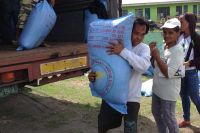Home -> News -> Media -> Aid Groups Move to Rice, Other Help in Philippines
Aid Groups Move to Rice, Other Help in Philippines

When Typhoon Haiyan first hit, Oxfam International distributed plastic tarpaulins to address the immediate need for shelter in the Philippines. Six weeks later, the group is tackling a longer-term challenge—restoring damaged rice paddies.
In the Philippines' hard-hit Leyte province, Oxfam recently handed out 400 tons of rice seed to thousands of farmers whose fields had been destroyed by the storm. The seed needs to go in the ground this month for the rice to be harvested in the spring.
Meanwhile, other aid groups, working with the Philippine government, are distributing cash as supermarkets reopen and drafting blueprints for sturdier homes for victims. The Nov. 8 typhoon killed more than 6,000 people, flattened homes and damaged crops in the central Philippines—an agricultural area accounting for 12.7% of the nation's gross domestic product.
The expansion of relief efforts beyond emergency food, water and temporary shelter is one sign that the Philippines is making progress in its recovery from Haiyan.
"I'm not chanting victory, but the extreme emergency phase is behind us by and large," said Bernard Kerblat, the United Nations High Commissioner for Refugees' representative to the Philippines.
Yet progress is uneven. While infrastructure and services have largely been restored to affected areas in northeast Panay Island, villages along the coast of southeastern Samar still need emergency rations of food and water, according to the United Nations World Food Program. And some smaller, more remote communities are receiving little aid outside of food and water six weeks after the storm, said Ton Berg, emergency coordinator for Doctors Without Borders.
"It's a very hazy line between emergency and recovery," said Ian Bray, a spokesman for Oxfam. "There are still a lot of people without homes."
More than one million houses were damaged by Haiyan, and more than 101,000 people are still living in government shelters.
To assist these displaced families, Habitat for Humanity is completing plans to build concrete houses costing about $5,000 apiece. The process can take months, and needs government approval. The group began rebuilding houses destroyed by the earthquake in Bohol, the Philippines, in December, two months after that disaster hit.
For Typhoon Haiyan victims, Habitat for Humanity distributed tarpaulin immediately after the storm that could be used to erect temporary shelters. The group also subsequently provided plywood, nails and other supplies to repair houses.
Meanwhile, with food stores reopening and supplies becoming affordable in a growing number of stricken areas, the World Food Program is working with the Philippine government to distribute cash to about 100,000 families so they can buy a "complete food basket in terms of nutrition," a U.N. project spokeswoman said. The WFP is also implementing a cash-for-work program that pays people for fixing homes and schools.
Overall, relief groups see a "long, long, long road ahead," said Mr. Bray. "We're making progress, but there's a long way to go."
For now, most nonprofit agencies helping with Haiyan recovery are seeing healthy donations ahead of the Christmas season. But they say that inadequate funding could become an issue as time passes. Philippine President Benigno Aquino III has said the rebuilding process could take four years.
"Our worry is that a few months from now, when this is no longer in the headlines, what will happen to the recovery," said Charlie Ayco, head of Habitat for Humanity in the Philippines.
- .U.S. Treasury looks to hold more cash to deal with future crises
- .Yum, McDonald's in Shanghai food safety investigation
- .Yellen defends loose Fed policy, says job market still too weak
- .Carl Icahn says 'time to be cautious' on U.S. stocks
- .Samsung Electronics says second quarter profit likely down 24.5 percent; worst in two years
- .U.S. jobs data seen reinforcing strong growth outlook
- .Asia stocks up on buoyant Wall Street, oil near highs

